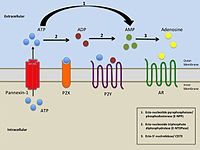| L-type lectin-domain containing receptor kinase I.9 | |||||||
|---|---|---|---|---|---|---|---|
| Identifiers | |||||||
| Organism | Arabidopsis thaliana | ||||||
| Symbol | LECRK19 | ||||||
| Alt. symbols | DORN1, LecRK-I.9 | ||||||
| Entrez | 836152 | ||||||
| RefSeq (Prot) | NP_001078773.1 | ||||||
| UniProt | Q9LSR8 | ||||||
| Other data | |||||||
| Chromosome | 5: 24.26 - 24.27 Mb | ||||||
| |||||||
| Part of a series on |
| Purinergic signalling |
|---|
 Simplified illustration of extracellular purinergic signalling Simplified illustration of extracellular purinergic signalling |
| Concepts |
| Membrane transporters |
DORN1 refers to a purinergic receptor found in green plants, which is involved in extracellular ATP detection. Through the process of signal transduction, DORN1 couples extracellular ATP binding (which occurs during cellular stress) to downstream signalling and ultimately gene expression, which is thought to aid in plant survival.
Molecular properties
In contrast to animal purinergic receptors (which are G protein-coupled receptors), DORN1 is a lectin receptor kinase (LecRK), and is part of the L type lectin receptor kinases, due to its legume-like extracellular domain.
In green plants such as Arabidopsis thaliana, several mutants lacking the DORN1 receptors are unable to phosphorylate mitogen-activated protein kinases after ATP stimulation.
Function
DORN1 receptors may play a role in mediating wound-induced inflammatory responses in green plants, with ATP acting as a damage-associated molecular pattern molecule. In response to cell lysis, ATP is discharged and binds onto the extracellular lectin domain of the DORN1 receptor. The intracellular DORN1 kinase domain is subsequently activated, resulting in several cellular responses such as mitogen-activated protein kinase activation, increased cytosolic calcium concentration and reactive oxygen species (ROS) production, ultimately leading to the induction of defence gene expression.
See also
References
- ^ Choi J, Tanaka K, Cao Y, Qi Y, Qiu J, Liang Y, Lee SY, Stacey G (January 2014). "Identification of a plant receptor for extracellular ATP". Science. 343 (6168): 290–4. Bibcode:2014Sci...343..290C. doi:10.1126/science.343.6168.290. PMID 24436418. S2CID 5029928.
- ^ Cao Y, Tanaka K, Nguyen CT, Stacey G (August 2014). "Extracellular ATP is a central signaling molecule in plant stress responses". Current Opinion in Plant Biology. 20: 82–7. doi:10.1016/j.pbi.2014.04.009. PMID 24865948.
- Bouwmeester K, Govers F (2009). "Arabidopsis L-type lectin receptor kinases: phylogeny, classification, and expression profiles". Journal of Experimental Botany. 60 (15): 4383–96. doi:10.1093/jxb/erp277. PMID 19773388.
- Adler EM (March 2014). "Of ATP receptors, opioid receptors, and AKAP regulation of calcium channels". The Journal of General Physiology. 143 (3): 313–4. doi:10.1085/jgp.201411175. PMC 3933938. PMID 24567506.
- Choi J, Tanaka K, Liang Y, Cao Y, Lee SY, Stacey G (November 2014). "Extracellular ATP, a danger signal, is recognized by DORN1 in Arabidopsis". The Biochemical Journal. 463 (3): 429–37. doi:10.1042/BJ20140666. PMID 25301072.